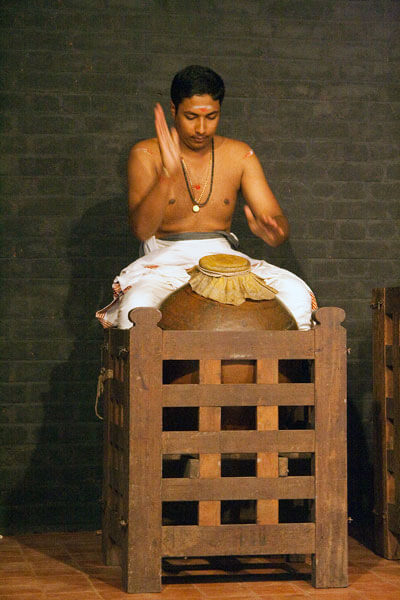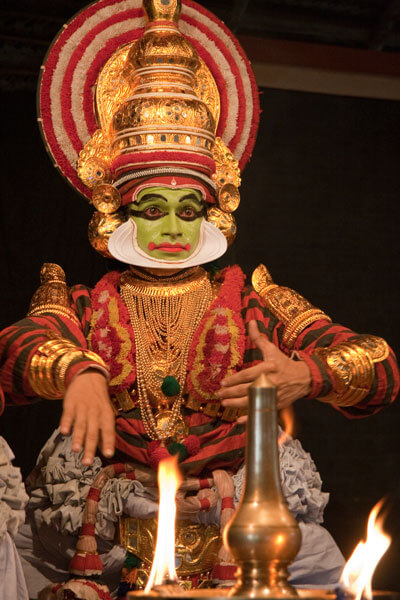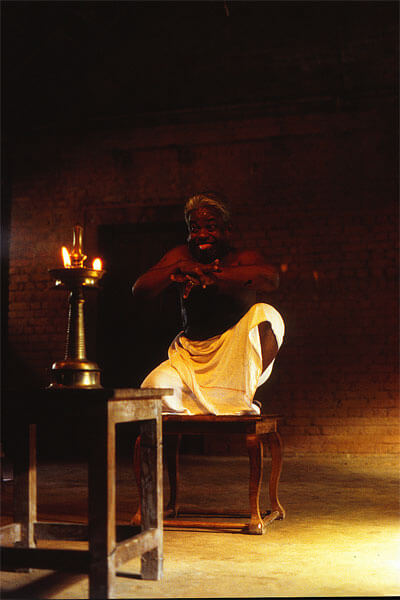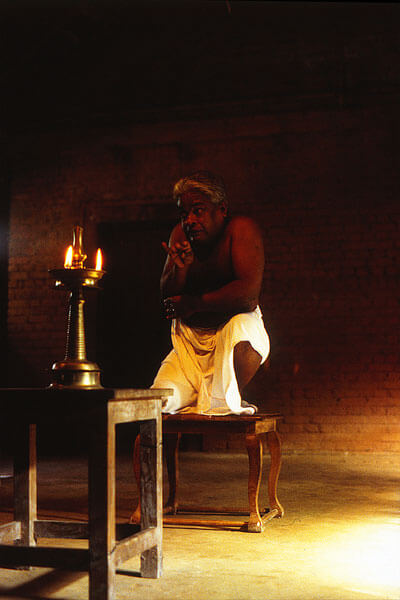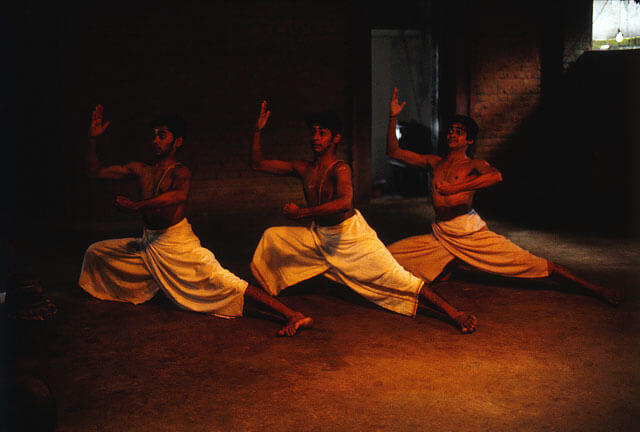Kutiyattam, The Only Surviving Form of Sanskrit Drama
Kutiyattam (also Kootiattam, Kootiyattam, Koodiyattam) is an old form of theatre, which until recently has been performed solely in the temple theatres, kootampalas, of Kerala, a state with an exceptionally strong Sanskrit tradition. Kutiyattam (lit. “acting and dancing together”) is traditionally performed by men of the Chakiar caste, and the music is played by men of the Nambiar caste, while the women of the Nambiar families, Nangiars, play the female roles.
Video clip: King Dusyanta and his charioteer are out hunting; the opening scene of Shakuntala, the most famous of all Sanskrit dramas Veli Rosenberg
Kutiyattam is a remarkable tradition in several ways. It is the sole example of an unbroken tradition of Sanskrit drama, which has already been discussed. It meticulously follows the instructions of the Natayashastra and the later, local acting manuals. In its relatively isolated performing milieu it has preserved its literary heritage, music, acting technique and costuming and make-up practices.
It was not well known in other parts of India or abroad until the latter half of the 20th century. It was officially included in the UNESCO list the Intangible Cultural Heritage of Humanity in 2008.
Origins and History
Literary evidence suggests that kutiyattam may have a history of some 1800 years. From the 14th century onwards the references became more numerous, giving information on several of its aspects. For centuries, kutiyattam was very popular and greatly appreciated by the rulers of Kerala.
It was only in the latter part of the 20th century that kutiyattam emerged from the kootampalas or temple theatres, which non-Hindus are not allowed to enter. It was added to the curriculum of the state theatre school Kalamandalam, and, later, private kutiyattam associations started to do research into it and also promote it internationally. One of these institutions is Natana Kairali, led by Sri G. Venu, better known as Venuji.
The Plays and the Languages
As has been mentioned above, Kerala has an exceptionally strong Sanskrit tradition. Thus it is no wonder that the classical Sanskrit dramas found their way to Kerala. In the beginning the repertoire of kutiyattam consisted of Sanskrit dramas written by writers mainly from northern India, such as Bhasa, Kalidasa, and Harsha.
The first Malayali writer from Kerala, who wrote his own Sanskrit dramas, was Kulasekhara Varma (c. 11th century). He is said to have also written a Kutiyattam manual, the Aattaprakaram. He is sometimes regarded as the “founder” of the art of kutiyattam.
Numerous local writers after him wrote plays for kutiyattam. They include large-scale heroic plays as well as shorter farces. Many of them are elaborations of episodes from the great epics, the Mahabharata and the Ramayana, as was also the practice in Sanskrit dramas.
In a similar way to Sanskrit dramas, there is also a clear hierarchy of languages in kutiyattam plays. Priests and men of the ruling class speak Sanskrit, while women, children, and ordinary folk use the local vernacular, Malayalam. As in Sanskrit dramas, so also in kutiyattam, the clown character can break this social hierarchy by moving freely on every level of society and translate the Sanskrit verses of the heroes into local Malayalam.
The Stage and the Music
Most of the kootampalas or the temple theatres, in which kutiyattam is performed, follow the instructions of the Natyashastra. Their ground plan is mostly rectangular and they are rather intimate in size, thus enabling the audience to enjoy the actors’ hand gestures and intricate facial expressions, which, without a doubt, form the highlight of the whole art form.
- A large oil lamp is the focal point of all action on the kutiyattam stage Jukka O. Miettinen
- A portable curtain behind which important characters are introduced Jukka O. Miettinen
- A mizhavu drum Jukka O. Miettinen
In front of the earthen stage there is always a big oil lamp. It is the focal point of all actions and it illuminates the actors’ faces and gestures. Behind the stage are two doors, which lead into the dressing room.
Important characters are introduced from behind a hand-held curtain carried by two stagehands. The characters then dramatically appear to make their mimetic self-introductions according to their specific temperaments. The curtain functions as a demarcation line between this world and the mythical world of fiction.
The dominant instrument is a huge copper drum, mizhavu, which is placed in its own wooden enclosure at the rear of the stage. Other instruments include cymbals, a small drum played with a stick, and a conch shell. Every now and then the actors utter their own lines in a most slow and stylised manner.
The Acting
Much of the brilliance of the acting lies in the body language, or the above discussed abhinaya style of acting. The acting is a very slow process, as almost every word is given a lengthy commentary by means of gestures and mime. Thus the performance of a single kutiyattam play usually takes several days. Some Sanskrit dramas may have taken up to 70 days to be enacted with the kutiyattam technique.
The actors often execute the long mimetic monologues while sitting on a wooden stool in front of the oil lamp. There also exists a solo form of kutiyattam called koothu, which is narrative in character. The female koothu, nangiarkuttu, will be discussed in the next chapter.
- King Dusyanta from the Sanskrit play Shakuntala Jukka O. Miettinen
- The King is shooting a deer Jukka O. Miettinen
- The King in love Jukka O. Miettinen
In the actual kutiyattam, in which several actors participate, the actor executing a long mimetic solo monologue is often left alone on the stage. When the monologue is finished, the other actors return to their places so that the dramatic action may again continue.
The actor’s mimetic skills are trained to such a high level that he is able, if the play demands, to simultaneously express different feelings with the right and left side of his face. He can also “mono act” a mimetic dialogue all by himself, for example, by indicating the change of role from God Shiva to his consort Parvati by changing the position of his shawl.
- A master is practising a mimetic monologue Jukka O. Miettinen
- A master is practising a mimetic monologue Jukka O. Miettinen
- Training of the energetic, “masculine” tandava technique of kutiyattam Jukka O. Miettinen
Because of the slow style of acting, which concentrates on elaborating the characters’ reactions, the enacting of a kutiyattam play in its entirety takes several days. That is why performances may start with kinds of flashback scenes in which the important events of the previous part are summarised.
Costumes and Make-up
Both in costuming and make-up kutiyattam is clearly an indigenous form of art. The actors’ wide, skirt-like lower garments are believed to have developed from archaic dance costumes made of leaves and other natural materials. A speciality of the cotton-made kutiyattam garment is that its back forms a kind of huge, intricate rosette constructed of tight draperies. The upper body and arms are covered with a long-sleeved jacket.
Heavy ornaments and headgear, mostly made of gilded wood, add to the kutiyattam’s exaggerated aesthetics, which bear clear, stylistic similarities to the 15th–17th century murals such as can be seen in the famous Mattancherry Palace in Kochi, in Central Kerala.
The make-up is usually non-naturalistic and brightly coloured. Some make-up types are characterised by a white frame-like ridge, made of thick rice paste (chutti). Although highly stylised, the make-up varies according to each specific role.
Later, this overall aesthetics was further developed in krishnanattan and particularly in kathakali, in which the make-up types were classified according to the specific character categories. The costuming and the ornaments took a further leap towards baroque abundance and reflected a fairytale-like mythical reality.


